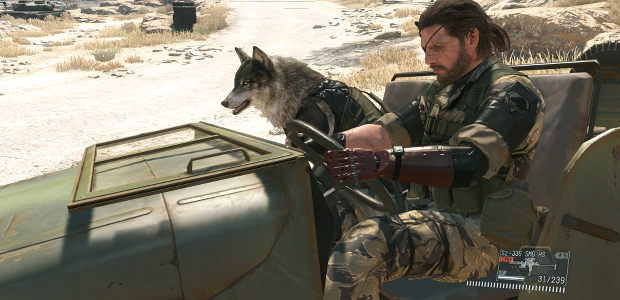Everyone s going to come out of MGSV with stories. After six hours with the game, I ve already got three. But here s the moment where The Phantom Pain first clicked for me. The objective is to kill a Spetsnaz commander in the middle of this enormous farm, with a house in the centre and multiple manned guard towers placed around the grounds. It s night, and I use my binoculars to identify the commander as he yells in Russian at his troops. Creeping across the fields and avoiding searchlights, I sleep dart one of the watchtower guards, and using the cover of darkness, creep towards the house where the target is standing, looking out of the window. The interior is lit orange, and as I pull out my silenced rifle to take the shot, I notice Kim Wilde s Kids In America is playing on cassette as the commander stands there. I put a bullet in his head first time and am advised to leave quickly. The guards scramble, but I keep my cool, crawl into the long grass and I m gone. No-one ever saw me. Perfect stealth playthrough.
But you know what? I really want Kids In America on cassette and I can t bear the idea of moving through the story without it. I restart the mission, go back in the daytime, fall afoul of the now changed AI patrols and get caught right away. I murder eight people on my way into the house to get that cassette. I whistle for my horse and gallop away with Kim Wilde. I can now play it on Snake s Walkman at any time during the rest of the game. I realise, in that moment, that I m murdering Russian soldiers to build what is basically my parents music collection.
The Phantom Pain has a few moments like this in its opening hours, the kind that I d more often associate with the Hitman series or Far Cry than Metal Gear. It s a proper sandbox game with a leaning towards stealth, but I hesitate to call it a purely stealth-driven game. MGSV validates any way you can think of playing it, and while its end-of-mission points system penalises you for getting caught, it also rewards you generously for landing headshots. The game doesn t judge you for the way you want to play—and the extensive weapon research system lets you support your methodology across the course of the game, whether you want to build a more powerful tranq gun or a grenade launcher.
The controls are far better than I m used to from the formerly console-only Metal Gear series. This feels like a world-class third-person action game, with comfortable precision aiming and really simple on-the-fly inventory management. If you ve finished the Ground Zeroes prequel, it feels exactly the same to play.
Of the six main story missions I ve finished, I found half were interesting, half were a little dull. The appeal of a level comes down to environmental design, for me, and this has varied so far. Levels with some kind of novel layout, like an enormous half-constructed bridge, or a ranch-like sprawl of watchtowers and fields with plenty of places to hide in, feel extravagantly designed and are worth replaying until I get the score I want. On the other hand, one level that requires finding and destroying some comms equipment in a largely anonymous settlement built into a hill was dull because the environment wasn t particularly memorable—MGSV needs good level design as well as interesting systems to reach its potential, and so far I m finding the former side of the game a bit mixed. But there s tens of hours of missions to go, so consider this a mere early impression and not a broad judgement.
The Afghanistan-set open world is pretty amazing to look at and explore, with a day and night cycle that can coincide with a shift in guard behaviour patterns, as well as random sandstorms that offer you a sneaking advantage in reduced visibility. The levels I ve played so far all co-exist in this one enormous landscape, which is bulked out with enemy landposts and resources to scavenge. While I haven t seen much in the way of landmarks, surveying an enemy base from atop a cliff feels amazing because it s all there, waiting to generate stories of unexpected failures and successes. The way AI interacts leads to neat or sometimes traumatising one-offs, like the time I rolled out the way of a charging bear I failed to take out with a tranq dart, only for the bear to crash into my loyal horse and kill it instantly.
If you ve never played a Metal Gear Solid game, that V in the title is largely irrelevant to enjoy what Kojima Productions has created here. This is all of Metal Gear s sandbox promise dialled up to maximum, without the convoluted backstory and notoriously long cutscenes of its previous iterations. You don t need to have a broad knowledge of its mythos to enjoy throwing a sleeping soldier out of a watchtower while you re listening to Bowie's The Man Who Sold The World. The only suggestion of a heavy narrative is in the deliberately confused hospital-set intro, which I personally think was spoiled way too much by early trailers for the game—I won t ruin it here because you should experience it first hand.
I ve played all the mainline Metal Gear games and most of the spin-offs, but to me, this feels like a new series, or at least a reboot—it s oddly story-lite, to the extent where I felt like I knew almost nothing about Snake beyond his motivation to rebuild his home base and get revenge on the people that destroyed his last one. He doesn t talk a lot, and most of the background info seems to be delivered through tapes that Snake can access on his Walkman, a touch which perhaps mitigates the lengthy cutscenes MGS is associated with but is really no more advanced as a means of delivering story than BioShock s audiotapes were.
Maybe the lack of a traditional narrative is the developers way of underlining that The Phantom Pain is about the stories generated by the players themselves. Me shooting the Spetsnaz officer while Kids In America played in the background is one example of that; the exact angle of Snake lining up the shot and the tension of doing so will live long in my memory, as will several other instances that followed this. Snake himself is a bit of an empty vessel, though, and right now it s hard to work out if that s a deliberate creative choice or if the characterisation here is just a bit weak.
As the missions grow in complexity and my options expand through the Mother Base upgrade system, I can t wait to see how the challenge escalates in Metal Gear Solid V. This is a tremendous PC version, too, and with my 780 it's more or less staying at 60fps with every graphics setting on extra high. Look out for my full review of the PC version later this week.








